Willie Jones III
Among Friends
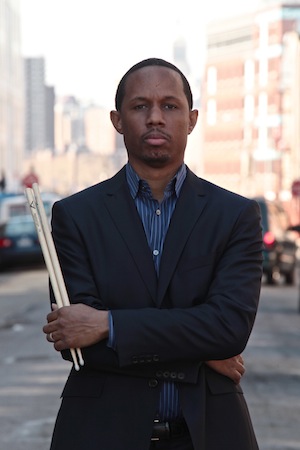
Rooted
in the hard bop tradition, Willie Jones III has developed a personal,
precise, swinging style. Just listen to his latest explosive album
Plays The Max Roach Songbook
(2013). Backed by Eric Reed (p), Dezron Douglas (b), Jeremy Pelt
(tp), Stacy Dillard (ts) and Steve Davis (tb), Jones plays with the
fire of his heroes and with the uncompromising state of mind of a
true straight-ahead jazz leader.
Born
in Los Angeles the 8th of June 1968, based in New York since 1997, Willie Jones
III has deepened all the creative aspects of a musician, as a
sideman, leader, composer and producer.
As a sideman, he worked
primarily with Arturo Sandoval (1995-1998), Roy Hargrove (1998-2005)
and Cedar Walton (2009-2013), not to mention the gigs, tours and
recording sessions with veterans such as Horace Silver, Herbie
Hancock, Houston Person, to name a few. Jones released five leader
albums, all of which include the magic touch of Eric Reed –Jones'
musical alter ego– on WJ3 Records, the label he founded in 1999. He
also produced on that label Eric Reed's Something
Is Beautiful (2011) and Reflections
Grareful Heart (2013) as well as Cyrus
Chestnut's The Cyrus Chestnut Quartet
(2012) and Soul
Brother Cool (2013). A representative
of cultured jazz, Willie Jones III has become indispensable.
Interview by Mathieu Perez
Photos Adrianna Mateo, Ernest Gregory, Mathieu Perez
© Jazz Hot #669, Autumn 2014
Jazz Hot:
What was it like
to grow up in Los Angeles in the 1970s?
Willie Jones
III: Growing in L.A. in
the 1970s was a great time! We still had a lot of jazz musicians,
like Teddy Edwards, Billy Mitchell, Freddie Hubbard etc. And there
were still quite a few local musicians and clubs at that time. You
didn’t have to go to Hollywood or Culver City to hear jazz.
Your father
Willie Jones (1932-2011) was a professional
jazz musician. What are your earliest memories of live music?
My father was a
musician so I got to go rehearsals and jam sessions. That’s my
foundation. 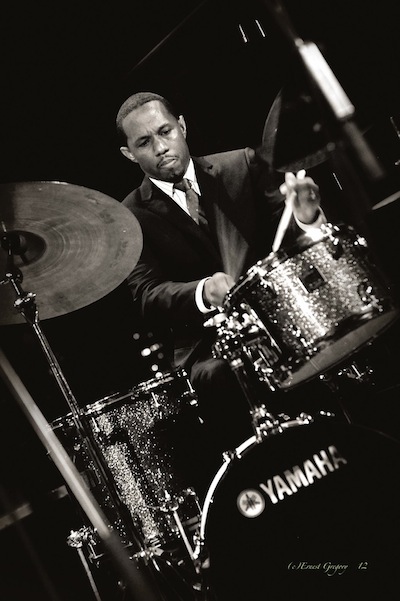
Where would he
play?
He played locally.
He played with Henry Franklin, Teddy Edwards, Oscar Brashear, George
Bohanan. He was the musical director of the Platters. That’s how he
made a living. And then he was playing jazz around town. That’s
what he was at his core, a jazz musician. He also did a lot of vocal
training for people like Ann-Margret and Shirley MacLaine.
How early were
you drawn to drums?
From day 1. I got to
see all these musicians. That’s what I wanted to do. I was always
trying to play drums. Then I became more serious about it.
Did you have teachers?
I started to take
private lessons with Clarence Johnson when I was 14; but I wasn’t
serious about practicing. (Laughs)
I got serious two years later. But that was my introduction to
private studies. And my dad would take me to gigs. When I got older,
I would go to sessions by myself and see musicians like Larry Gales.
Were you always focused
on playing only straight-ahead jazz? I love all kinds of
music but as far as making a living it was always straight-ahead
jazz.
At what point did
you study at CalArts?
I got out of high
school and went to City College for 2 years. I was starting to play
around town. CalArts was sponsoring some kind of workshop at the
Watts Towers. I believe James Newton was there. He was also teaching
at CalArts and I was picked with bass player Marcus Shelby and guitar
player Hideaki Tokunaga for a scholarship there.
Who were your mentors?
I had a couple of
mentors. James Newton was really responsible for getting me into
CalArts and he was one of my teachers. He was also one of my first
gigs. It opened a whole new world for me.
How long did you study
there?
I was there 2 years.
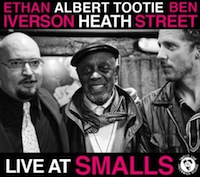
One of your
teachers was Albert Tootie Heath. What did you learn from him?
Tootie is like a
comedian/drummer! He’s very funny but very serious about the music
and the drums. He’s very musical. He was always getting me to play
more because I had developed a certain amount of technique by the
time I arrived at CalArts. But I wasn’t very musical.
How would you work with
him?
There would be two
drum sets in a private room and we played tunes. He would have me
solo and show me certain things.
Meeting Billy
Higgins (Jazz Hot
#474) was another turning point for you.
I never took an
official lesson with Billy Higgins. I used to watch him practice all
the time. It was like a drum solo. He had a workshop that still
exists in L.A. called the World Stage.
Were you curious about
the other veteran drummers?
I was curious to
listen to more to as many drummers as possible. My first influences
were Philly Joe Jones, Max Roach, Jimmy Cobb, Art Blakey. They’re
the drummers that I first heard. By the time I was 20 I got deeper
into their work.
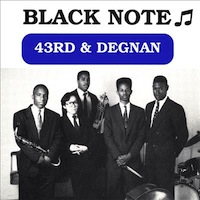
When did you go to New
York for the first time?
At CalArts I had a
chance to compete at the Monk Competition. That was in 1992. That was
the first time I was going to New York. I didn’t win it of course
but it really sealed it for me because Billy (Higgins) was telling me
that I should move to New York. When I got there, I got a chance to
meet Benny Carter, Wynton Marsalis etc., and I got to be in this
atmosphere with all those other drummers. You see, in L.A., I was the
only serious drummer that was playing jazz. From that point on I knew
I wanted to move to New York. I went back to school for one year and
then I started touring
When did you form
your first band Black Note?
That group started
at Billy Higgins’ workshop. That’s where we first met. We were
doing gigs around L.A. and in California. We made a couple of
records. What was your
first touring gig experience?
My first touring gig
was with Arturo Sandoval. I started to play with him when I was still
at CalArts. It was in 1993. His regular drummer Aaron Serfaty was a
classmate of mine at CalArts. He’s a great drummer. And he got like
a six-week tour with some other band and asked me to sub for him. And
before I knew it, I was playing Latin jazz! (Laughs)
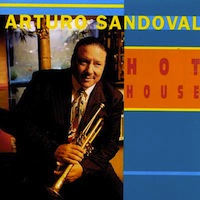
How long did you
stay with Arturo Sandoval (Jazz
Hot #626)?
I was his drummer
for 3 years. But before that I was subbing.
Coming from a
more straight-ahead jazz background, were you comfortable playing
Latin jazz?
It was incredible!
As a matter of fact, I didn’t appreciate it nearly as much as I
should have. During the first tour I did with him, he was playing the
music of Clifford Brown. So a lot of it was really straight-ahead
jazz but he was doing a lot of Latin tunes. Looking back, I should
have been more serious about exploring those types of rhythms.
How was it playing with
him?
It was great. Arturo
is all about technique. He’s a genius! He can play piano, timbale
and the trumpet of course. He can do everything! His set-up is like a
show. I had to make sure I had my technique together. (Laughs)
It was my first time on that type of stage with that type of energy!
I was sweating every night! (Laughs)
He was always nice to me and very patient. At that time, I felt that
my playing was terrible with that kind of music but in 1995 I turned
out to be his regular drummer.
You played with
many veterans. Did you start to meet them in Los Angeles?
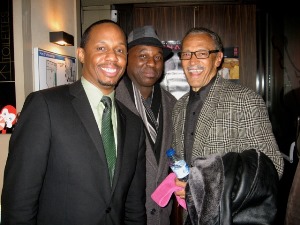 I was one of the
young guys in L.A at the time playing jazz. So if George Coleman was
in town and needed a drummer, they would call me. I played a week
with him at the Jazz Bakery. I did a three-week tour with Milt
Jackson on the West Coast. That was in addition to playing with
Arturo. I was running. I knew they were great gigs but it took me a
few years to realize with whom I had played with and to get that I
was living the life I had always dreamed of. I was one of the
young guys in L.A at the time playing jazz. So if George Coleman was
in town and needed a drummer, they would call me. I played a week
with him at the Jazz Bakery. I did a three-week tour with Milt
Jackson on the West Coast. That was in addition to playing with
Arturo. I was running. I knew they were great gigs but it took me a
few years to realize with whom I had played with and to get that I
was living the life I had always dreamed of.
When did you move to
New York?
I moved to New York
in June of 1997. And that same week I played at the Blue Note with
Arturo Sandoval. A few months later I joined Roy Hargrove’s band.
You stayed with
Roy Hargrove (Jazz Hot
#594) many years.
I stayed with him 8
years.
Did you have much work
when you relocated to New York?
I was with Arturo
when I moved to New York and I was playing with Roy at the same time.
In between I played with Horace Silver and we did a record.
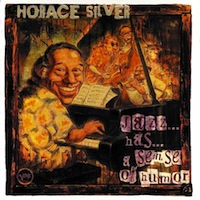
When did you meet
Horace Silver (Jazz Hot
#528)?
I met Horace a few
years back in L.A. I also auditioned for him two years before I moved
to New York but I didn’t get the gig. I thought I should’ve!
(Laughs)
This was in 1995 or 1996. In New York, he
called me and wanted me to go back to L.A. to audition again.
Respectfully I told him that I wouldn’t but if he wanted me to play
drums with him I would love to. He called me up and asked me to join
his band. That was the summer of 1997.
You told me you
had a chance to meet Donald Byrd around that time.
Donald Byrd came to
one of the shows when I was playing with Horace Silver. I met him a
couple of times. He was the real thing. My father had Modern
Jazz Perspective. That’s one of my
favorite records.
So you worked
immediately as soon as you relocated to New York. Who did you play
with at that time?
I worked as soon as
I got to New York. I was very fortunate. I played with Roy Hargrove,
Horace Silver, Hank Jones, Herbie Hancock, Cedar Walton.
You played with
Roy Hargrove, in his quintet and with the RH Factor. What do you keep
from this experience?
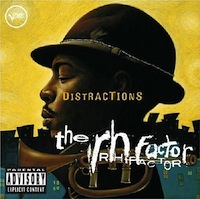 The RH Factor was a
great experience but that music wasn’t really my style. My original
plan after the quintet sort of stopped was to leave. But they talked
me into staying. They wanted to tour with two drummers and I already
had met Jason Thomas. He’s a great drummer. That tour turned into 2
years. It was great. We played some great funk music. It was a great
experience. I especially like the Hard
Groove and Distractions
albums. The RH Factor was a
great experience but that music wasn’t really my style. My original
plan after the quintet sort of stopped was to leave. But they talked
me into staying. They wanted to tour with two drummers and I already
had met Jason Thomas. He’s a great drummer. That tour turned into 2
years. It was great. We played some great funk music. It was a great
experience. I especially like the Hard
Groove and Distractions
albums.
Eric Reed (Jazz
Hot #641) is featured in all
your albums as a leader. Is he the musician that you connect with the
most?
I met Eric in
church. We’re about the same age. I’ve known Eric longer that I
have known any other jazz musicians. We met with my uncle who’s a
gospel singer. I used to play in church. That was many years ago.
This is before I knew Eric played jazz. I wasn’t sure but I had a
feeling he was into jazz because he played so well. A few years
later, he was playing with Wynton Marsalis. He was the same guy that
I used to play with at church. Of my generation, he’s my favorite
pianist with Cyrus Chestnut. Eric and I have a strong musical bond.
Everything I like to hear in a pianist he has. If I have a project of
my own, I usually like him to be a part of it.
What do you look
for in another musician?
It’s got to be
swinging and be very musical. Eric Reed is the epitome of that. If
you’re playing jazz, you’ve got to swing.
Did you know
Cedar Walton (Jazz Hot
#520) before working with him?
I met Cedar through
Billy Higgins. So that was years ago. I was his regular drummer for 5
years. Even before that I would sub for Lewis Nash, Joe Farnsworth,
Kenny Washington.
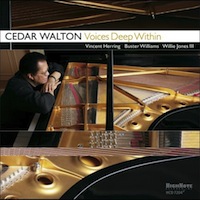
Was it a dream come to
work with him?
Talking about a
dream come true, that’s it! I remember the Cedar Walton trio
playing in L.A. with Billy Higgins and David Williams. I was always
there! I got to learn all his tunes years ago. His songs stay with
you. He doesn’t really get the credit that he should for all the
great songs he has written.
What was Cedar
Walton’s style?
He was an incredible
pianist. As a bandleader, he knew what he wanted but he would give
you a lot of space to express yourself. He respected your creativity
and what you might bring to the table. Sometimes some leaders try to
micromanage you, it’s a like being in a straitjacket. I like it
better when they trust the musicians more. Cedar was great at that.
Were you very
familiar with his personal repertoire before playing with him?
Before I played with
him I thought I knew most of his songs. When I started to work with
him, I realized I didn’t know half of his tunes. And I knew a lot
of them!
How close were
you to Cedar Walton?
We had a bond. I had
a friendship with Cedar and David (Williams) before playing with
them. Billy Higgins introduced me to the musicians he played with.
Cedar came down to Billy’s workshop and taught us his tunes. David
would come by too. But playing with them in the trio and travelling
with them, it became like an extended family.
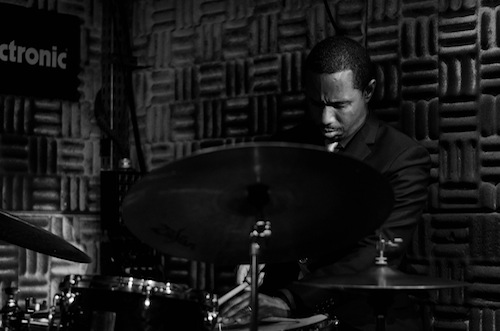
You created your
own label WJ3 Records and recorded five records as a leader and
produced artists Eric Reed and Cyrus Chestnut (Jazz
Hot #559). How did its concept
evolve over the years?
At the beginning,
nobody else would sign me. I just wanted to record. So I created my
label out of a necessity. Some people record themselves until they
have a major deal. I have no interest in doing that. Before it was a
necessity, now I have created a body of work and it has expanded to
Eric Reed, to Cyrus Chestnut. I want to continue that and continue
the legacy of Max Roach, Mingus who had their own companies.
What was the
inspiration for your records as a leader?
For the first two
records, Volume 1… Straight Swingin’
and Volume 2…
Don’t Knock The
Swing, I
wanted to document the people I was playing with at that time. In the
first one, there was Gerald Cannon on bass, Sherman Irby on
saxophone. We played together in Roy Hargrove’s group. Then there
was the other sax player James Mahone, who worked with me in Black
Note. He moved to New York with me. There was Billy Childs on a
couple of tracks. I used to see Billy in L.A. So it was important for
me to document playing with them. And there was Eric Reed of course.
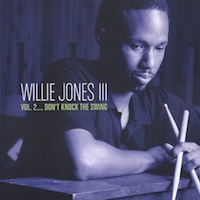
It’s like a
form of a musical biography…
Yes. In the second
album, there was again Gerald Cannon, Roy Hargrove, Steve Davis, who
I worked locally around in New York. Yes it was like a form of
biography. It
gives an idea where you are at in your career. In the third record,
Volume 3,
I started to think more in terms of conception. I wanted to do a trio
and used these two particular musicians, Eric Reed and Dwayne Burno.
After that for The Next Phase,
I wanted to have Cedar Walton’s Timeless
All Stars
sound with the vibes, the trombone and the tenor. I was thinking of a
certain sound.
Contact
www.williejones3.com
Discography
Leader
CD
2001. Vol 1 … Straight Swinging, WJ3 Records 31001
CD
2003. Vol 2 … Don't Knock the Swing, WJ3 Records 31003
CD
2006. Vol 3, WJ3 Records 31005
CD
2010. The Next Phase, WJ3 Records 31008
CD
2013. Willie Jones III Plays the Max Roach Songbook, WJ3 Records
31012
Sideman CD
1982-2003. Montreal Jazz Festival Vol 1 : Very best Live,
Universal 986287
CD
1991. Black Note, 43rd
& Degnan, World Stage 1011
CD
1993. Black Note, L.A. Underground, Red Records RR 123259-2
CD
1993. Cliff Brown, In the Meantime, All-in-One 31731
CD
1993. Black Note, Jungle Music, Columbia 57825
CD
1994. Kei Akagi, Mirror Puzzle, Audioquest AQ 1028
CD
1995. Black Note, Nothing but the Swing, Impulse! IMPD 177
CD
1996. Hideaki Tokunaga, The Wind Told Me, Moo 5005
CD
1996-97. Matt Otto, 53 West 19th,
Noir Records 21
CD
1996-97. Joe Gaeta, Art of the Workingman, Rhombus Records / Positone
7009
CD
1997. Arturo Sandoval, Hot House, N2K Encoded Music 10023
CD
1997. Anthony Wilson, Anthony Wilson, Mama Foundation MMF 1018
CD
1997. Kamau Daaoud, Leimert Park, Mama records 1019
CD
1998. Anthony Wilson, Goat Hill Junket, Mama Foundation MMF 1022
CD
1998. Horace Silver, Jazz … Has … a Sense of Humor, Impulse! IMPD
293-2
CD
1998. Anthony Wonsey, Open the Gates, Cris Cross Jazz 1162
CD
1998. Ryan Kisor, Point of Arrival, Criss Cross 1180
CD
1998. Doug Lawrence, High Heel Sneakers, Fable Records 54303
CD
1998. Anthony Wonsey, Open the Gates, Criss Cross 1162
CD
1998. Charles Wright, Going to the Party, M$Wm Records 2001
CD
1998. Ryan Kisor, The Usual Suspects, Fable Records 54267
CD
1999. Roy Hargrove, Moment to Moment, Verve 543 540-2
CD
1999. Eugene Maslov, The Face of Love, Mack Avenue 1002
CD
2000. Phil Woods, Voyage : Phil Woods with the Bill Charlap
Trio, Chiaroscuro CR 368
CD
2000. Sherman Irby, Black Warrior, Black Warrior 1001
CD
2000. Jim Rotondi, Reverence, Criss Cross 1209
CD
2000. John Harrington, Love's Divine, Orchard 7468
CD
2001. Peter Beets, New York Trio, Criss Cross 1214
CD
2001. Jesse van Ruller, Here and There, Cris Cross 1217
CD
2001. Ryan Kisor, The Dream, Cris Cross 1215
CD
2002. Ryan Kisor, Awakening, Criss Cross 1239
CD
2002. Roy Hargrove RH Factor, Hard Groove, Verve 065192
CD
2002. Peter Beets, New York Trio Page Two, Criss Cross 1237
CD
2003. Jon Mayer, The Classics, Reservoir RSRCD 175
CD
2004. Roberta Gambarini, Easy to Love, In & Out 02070842
CD
2004. Grant Stewart, Grant Stewart + 4, Criss Cross 1269
CD
2004. Sherman Irby, Faith, Black Warrior 1002
CD
2004. Roy Hargrove RH Factor, Strength EP, Verve 9863348
CD
2005. Eric Reed, Here, MaxJazz MXJ 216
CD
2005. Peter Zak, For Tomorrow, SteepleChase SCCD 31592
CD
2005. Julius Toledano, Just the Beginning, Sharp Nine Records 1034
CD
2006. Wycliffe Gordon-Eric Reed, We, Vol. 2, WJ3 Records 31006
CD
2006. Tom Scott, Bebop United, Telarc MCGJ 1021
CD
2006. Roy Hargrove RH Factor, Distractions, Verve 000598702
CD
2006. Roy Hargrove, Nothing Serious, Verve 9888507
CD
2007. Marcus printup, London Lullaby, SteepleChase 31655
CD
2007. Marilyn Scott, Every Time We Say Goodbye, Venus 890974
CD
2007. Kurt Elling, Nighmoves, Concord Jazz 7230138
CD
2007. Houston Person, Thinking of You, High Note HCD 7177
CD
2007. Tom Guarna, Wingspan, SteepleChase 31634
CD
2007-2008. Joe Cohn, Shared Contemplations, Criss Cross 1309
CD
2008. Eric Reed, Stand !, WJ3 Records 31007
CD
2008-10. Ernestine Anderson, Nightlife, High Note HCD 7213
CD
2009. Eric Reed & Cyrus Chestnut, Plenty Swing, Plenty Soul,
Savant SCD 2104
CD
2009. Ernestine Anderson, A Song for You, High Note HCD 7187
CD
2009. Cory Weeds, Everything's Coming Up Weeds, Cellar Live Records
11909
CD
2009. Yotam Silberstein, Next Page, Positone 8050
CD
2009. Pamela Luss, Sweet and Saxy, Savant SCD 2103
CD
2009. Cedar Walton, Voices Deep Within, High Note HCD 7204
CD
2009. Stevie Holland, Before Love Has Gone, 150 Music 9
CD
2009. Steve Davis, Live at Smalls, Smallslive SL 0005
CD
2009. Noah Haidu, Slipstream, Positone 8077
CD
2010. Lisa Kirchner, Something to Sing About, Albabany Music
Distribution TROY 1268
CD
2010. Tim Mayer, Resilience, Jazz Legacy 1101015
CD
2010. Cyrus Chestnut, The Cyrus Chestnut Quartet, WJ3 100100
CD
2010. Houston Person, Moment to Moment, High Note HCD 7217
CD
2010. Justin Robinson, In the Spur of the Moment, WJ3 Records 31011
CD
2010. Charles Wright, Music in the Times We Live in, M$Wm Records
2002
CD
2010. Suzanne Pittson, Out of the Hub : The Music of Freddie
Hubbard, Vineland Records VLCD 7757
CD
2011. Cedar Walton, The Bouncer, Half Note 7223
CD
2011. Piero Odorici, Savant SCD 2115
CD
2011. Elio Villafranca, Caribean Tinge : Live from Dizzy's Club
Coca Cola, Motéma 233854
CD
2011. Floriaan Wempe, Flo's Flow, Challenge Records 73347
CD
2011. Charles Wright, That Funky Thang, M$Wm Records 2005
CD
2012. Jacques Lesure, When She Smiles, WJ3 Records 31014
CD
2012. Desron Douglas, Live at Smalls, Smallslive SL 0028
CD
2013. Cyrus Chestnut, Soul Brother Cool, WJ3 Records 31013
CD
2013. Steve Turre, The Bones of Art, High Note HCD 7251
CD
2013. Justin Robinson, Alana's Fantasy, Criss Cross 1371
Videos
Willie
Jones III, « The Thorn », extrait de The
Next Phase (2009) Willie
Jones III (dm), Eric Reed (p), Dezron Douglas (b), Greg Tardy (sax),
Steve Davis (tb), Warren Wolf (vib)
Cedar
Walton Trio, « Cedar’s Blues », Live 2013 Cedar
Walton (p), David Williams (b), Willie Jones III (dm)
Roy
Hargrove Quintet, « Circus », Festival de Jazz de Berne
(Allemagne), 2000 Roy
Hargrove (tp), Sherman Irby (sax), Larry Willis (p), Gerald Cannon
(b), Willie Jones III (dm)
Arturo
Sandoval, « Hot House », extrait de Hot
House (1998)
*
|

